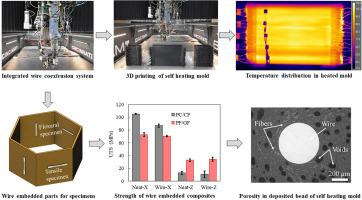Additive Manufacturing ( IF 10.3 ) Pub Date : 2021-09-11 , DOI: 10.1016/j.addma.2021.102282 Kazi Md Masum Billah 1, 2 , Jesse Heineman 1 , Parithosh Mhatre 1 , Alex Roschli 1 , Brian Post 1 , Vipin Kumar 1 , Seokpum Kim 1 , Gregory Haye 3 , Jerry Jackson 3 , Zach Skelton 3 , Vlastimil Kunc 1 , Ahmed Arabi Hassen 1

|
Large-scale material extrusion additive manufacturing technology is becoming the new mainstream technology for scaled-up composite mold and die applications. This paradigm shift in composite processing technology is primarily driven by out-of-autoclave tooling applications, in which fiber reinforced composite molds with scaled-up sizes and embedded heating elements are attractive. The present research describes the design, manufacturing, and testing of self-heating composite molds fabricated via a large-scale pellet extrusion 3D printing machine with an integrated wire co-extrusion tool. Polycarbonate (PC) composites reinforced with carbon fiber (PC/CF; 20 wt.%) and glass fiber (PC/GF; 20 wt.%) were used to fabricate mold parts. Joule heating thermal test results showed that uniform temperatures (~100 °C) were achieved for both PC/CF and PC/GF mold surfaces, using a custom-made feedback control power supply and infrared thermography. Mechanical characterizations, including tensile and flexural testing were performed on the wire-embedded and un-wired PC/CF and PC/GF base specimens to investigate the impact of the fiber reinforcement as well as the embedded wires. In the direction of extrusion, the ultimate tensile stress of PC/CF was 105 MPa, and that of PC/GF was 73 MPa, while the neat PC value was 64 MPa. Inner-bead voids and interfacial gaps were observed and characterized via optical and scanning electron microscopy. The embedded wires and inner bead impacted the mechanical properties of the composites. However, the stiffness of the wire-embedded mold was still satisfactory, proving that the technology can be used to fabricate additively manufactured out-of-oven/autoclave molds.
中文翻译:

自热模具的大规模增材制造
大规模材料挤出增材制造技术正在成为复合材料模具和模具大规模应用的新主流技术。复合材料加工技术的这种范式转变主要是由非高压釜工具应用驱动的,其中具有放大尺寸和嵌入式加热元件的纤维增强复合材料模具很有吸引力。本研究描述了通过具有集成线材共挤出工具的大型颗粒挤出 3D 打印机制造的自热复合模具的设计、制造和测试。用碳纤维 (PC/CF; 20 wt.%) 和玻璃纤维 (PC/GF; 20 wt.%) 增强的聚碳酸酯 (PC) 复合材料用于制造模具零件。焦耳加热热测试结果表明,使用定制的反馈控制电源和红外热成像,PC/CF 和 PC/GF 模具表面均实现了均匀的温度 (~100 °C)。对嵌入线材和未线材 PC/CF 和 PC/GF 基础试样进行了机械表征,包括拉伸和弯曲测试,以研究纤维增强材料和嵌入线材的影响。在挤压方向上,PC/CF 的极限拉伸应力为 105 MPa,PC/GF 的极限拉伸应力为 73 MPa,而纯 PC 值为 64 MPa。通过光学和扫描电子显微镜观察和表征内部珠子空隙和界面间隙。嵌入的线材和内珠影响了复合材料的机械性能。然而,











































 京公网安备 11010802027423号
京公网安备 11010802027423号